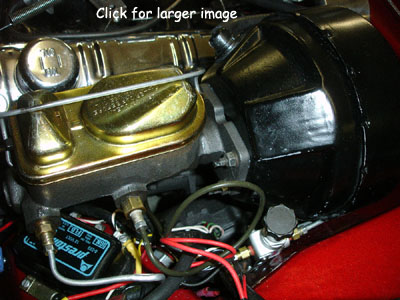Avanti Readers
I wanted to follow up with some additional information on two articles that I had written and were published in the Avanti Magazine in the past year. These two articles detailed converting my 1963 Avanti to disc brakes using the Turner disc brake conversions kits, for both the front brakes and then for the rear. I had also detailed the replacement of my master cylinder to a dual chambered unit and supplied a complete list of part numbers for those who wanted to follow in my steps.
I reported that my car stopped on a dime with the conversion complete, and indeed it does. But in a real live panic-braking situation a few weeks back, I learned that my rear brakes locked before the front ones did, and that was not good. The desired situation is the opposite- for the front brakes to lock slightly ahead of the back ones. When the back brakes lock first, the car can get really unstable and even sideways. Though in this instance my car stayed under control, it was an unnerving experience. I am reminded of a technical journal article I once read that said that balancing brakes front to rear is a critical part of a manufacturer's new car engineering, and that making changes to that originally engineered complete group of parts requires the mechanic to be quite cautious.
 I have since installed an adjustable front to rear brake proportioning valve to allow me to adjust the brake bias more to the front. (www.summitracing.com, part number SUM-G3905 $38.95)
I have since installed an adjustable front to rear brake proportioning valve to allow me to adjust the brake bias more to the front. (www.summitracing.com, part number SUM-G3905 $38.95)  . Adding the valve between the master cylinder and the rear brakes required nothing more than a 12" piece of brake line with fittings from the local auto parts store. In less than an hour I had made a small mounting bracket with a small piece of scrap steel, and attached the valve to the inner fender next to the brake booster using the same screw hole that secures the power steering hose clamp. While this valve seemingly can just be left unfastened and hanging in the air, I recommend attaching it solidly to something so that the vibration and leverage from the bouncing weight of it does not cause the tubing to fatigue and maybe eventually break.
. Adding the valve between the master cylinder and the rear brakes required nothing more than a 12" piece of brake line with fittings from the local auto parts store. In less than an hour I had made a small mounting bracket with a small piece of scrap steel, and attached the valve to the inner fender next to the brake booster using the same screw hole that secures the power steering hose clamp. While this valve seemingly can just be left unfastened and hanging in the air, I recommend attaching it solidly to something so that the vibration and leverage from the bouncing weight of it does not cause the tubing to fatigue and maybe eventually break.
After re-bleeding the brakes, a test in a deserted parking lot showed that the valve needed to be turned almost halfway closed to cause the desired result. (According to its packaging, a fully closed valve results in a 47% restriction to the rear brakes). That is a significant variation from not having the valve in place at all.
As unappealing as the thought of making repeated test panic stops in a mall parking lot might be, I suggest that the thought of an accident on the highway is far worse. May I please suggest to owners who are making adaptations to their brakes from stock consider testing them under adverse conditions before such a situation presents itself unexpectedly? I feel it is my obligation to share this information with readers.
Sincerely,
Bill Henderson

